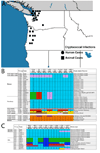Molecular evidence that the range of the Vancouver Island outbreak of Cryptococcus gattii infection has expanded into the Pacific Northwest in the United States
- PMID: 19220140
- PMCID: PMC2715219
- DOI: 10.1086/597306
Molecular evidence that the range of the Vancouver Island outbreak of Cryptococcus gattii infection has expanded into the Pacific Northwest in the United States
Abstract
Cryptococcus neoformans frequently causes fungal meningitis in immunocompromised patients, whereas the related species C. gattii is restricted to tropical and subtropical regions,where it usually infects immunocompetent individuals.An outbreak of C. gattii infection that began in 1999 on Vancouver Island has resulted in endemic C. gattii infection and caused numerous human and veterinary infections; the outbreak's range has spread to mainland British Columbia. The outbreak-related isolates have been molecular type VGIIa, the major genotype, or VGIIb, the minor genotype. Since 2006, human and veterinary cases of C. gattii infection have emerged in Washington and Oregon. Multilocus sequence typing demonstrates the spread of C. gattii VGIIa and VGIIb from Vancouver Island to the Pacific Northwest. Clinical strains recovered in Oregon represent a unique VGIIc genotype.
Conflict of interest statement
Figures


References
-
- Casadevall A, Perfect J. Cryptococcus neoformans. Washington DC: ASM Press; 1998.
-
- Bovers M, Hagen F, Kuramae EE, Boekhout T. Six monophyletic lineages identified within Cryptococcus neoformans and Cryptococcus gattii by multilocus sequence typing. Fungal Genet Biol. 2008;45:400–421. - PubMed
-
- Fraser JA, Giles SS, Wenink EC, et al. Same-sex mating and the origin of the Vancouver Island Cryptococcus gattii outbreak. Nature. 2005;437:1360–1364. - PubMed
-
- Hoang LM, Maguire JA, Doyle P, Fyfe M, Roscoe DL. Cryptococcus neoformans infections at Vancouver Hospital and Health Sciences Centre (1997–2002): epidemiology, microbiology and histopathology. J Med Microbiol. 2004;53:935–940. - PubMed

